I did a quick inspection of the hives today to see what I might need to do. I am going to the mountains where a friend has empty supers from when he was a beekeeper and he has offered to give me some. I needed to see how full my current supers are.
I opened both hives to find that each hive has full supers of honey that is capped and ready to take from the hive. Bermuda has three supers full of capped honey. I moved the empty super from Bermuda to a lower place in the hive - this is the fourth shallow super and it had honey in it as well but wasn't being worked on as eagerly as the other ones.
Destin had two supers full of capped honey. The bees are working hard on the third super which is just above the medium brood chamber.
I will definitely need to get some of his supers when I see him next.
The most interesting thing I saw were dead hive beetles. I saw a few live ones - not at many as the last time I opened the hives, but then I found the same thing in each hive. In one of the honey supers I pried the frames up one at a time to look at them. As I lifted one of the frames I saw seven small hive beetles propolized at the end of the frame between the frame and the shelf that holds it. Amazingly when I opened the other hive, I found pretty much the same thing - four or five small hive beetles propolized at the end of one of the frames. I'm sad I didn't have my camera with me.
Hooray for my girls - they are protecting their hive, stores and brood quite well.
This is the tale that began in 2006 in my first year of beekeeping in Atlanta, GA. ...there's still so much to learn.
Welcome - Explore my Blog
I've been keeping this blog for all of my beekeeping years and I am beginning my 19th year of beekeeping in April 2024. Now there are more than 1300 posts on this blog. Please use the search bar below to search the blog for other posts on a subject in which you are interested. You can also click on the "label" at the end of a post and all posts with that label will show up. At the very bottom of this page is a list of all the labels I've used.
Even if you find one post on the subject, I've posted a lot on basic beekeeping skills like installing bees, harvesting honey, inspecting the hive, etc. so be sure to search for more once you've found a topic of interest to you. And watch the useful videos and slide shows on the sidebar. All of them have captions. Please share posts of interest via Facebook, Pinterest, etc.
I began this blog to chronicle my beekeeping experiences. I have read lots of beekeeping books, but nothing takes the place of either hands-on experience with an experienced beekeeper or good pictures of the process. I want people to have a clearer picture of what to expect in their beekeeping so I post pictures and write about my beekeeping saga here.Master Beekeeper Enjoy with me as I learn and grow as a beekeeper.
I began this blog to chronicle my beekeeping experiences. I have read lots of beekeeping books, but nothing takes the place of either hands-on experience with an experienced beekeeper or good pictures of the process. I want people to have a clearer picture of what to expect in their beekeeping so I post pictures and write about my beekeeping saga here.Master Beekeeper Enjoy with me as I learn and grow as a beekeeper.
Need help with an Atlanta area swarm? Visit Found a Swarm? Call a Beekeeper. (404) 482-1848
Want to Pin this post?
Thursday, July 27, 2006
Saturday, July 22, 2006
It's finally raining in Atlanta!
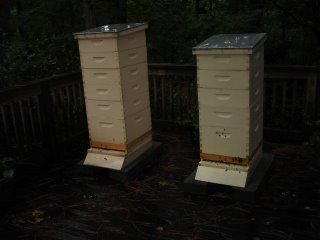
I woke up to a thunderstorm this morning. We've been without rain for a very long time.
At 7 AM I went out to see the bees. Wet clumps were clinging to the hive to dry off. If you click on the second picture to enlarge it, you'll see how wet the bees are.
I thought the lower bee in the third photo was dead. I brushed her with a pine needle and she moved. She is hanging onto the hive to dry off her wings before she can move again.
A few bees took shelter in the handhold of the super!
I wonder what goes on in the hives when it rains? All of the bees have designated jobs and they keep the place spotless. When I can't garden, I can always clean out a closet. What do bees do? Some of them must feel an intense desire to fly. I see bees coming in and out of the hive even with the rain falling.
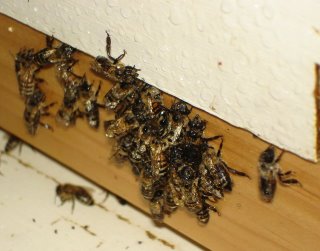



Friday, July 21, 2006
New super for Bermuda hive
I added a fourth shallow super to Bermuda on Wednesday.
I'll check both hives tomorrow to see how the honey production is going. I am now out of supers. I've ordered some more but another possibility is to take the honey from a full super and put the empty frames and super back on the hive.
Depending on how things look during my inspection tomorrow, I may decide to do that in a couple of weeks.


I'll check both hives tomorrow to see how the honey production is going. I am now out of supers. I've ordered some more but another possibility is to take the honey from a full super and put the empty frames and super back on the hive.
Depending on how things look during my inspection tomorrow, I may decide to do that in a couple of weeks.


Sunday, July 16, 2006
Attack of the Bee-Eater
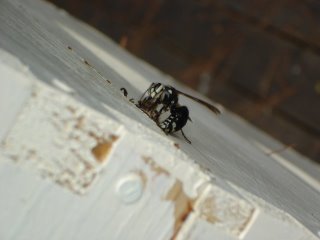
One of the sad parts of inspecting the hives is that bees are killed when I set the supers back in place. Yesterday a number of bees died during the inspection. One bee body was still caught between two supers this morning. Usually by the end of the day, the housekeeping bees have cleaned everything off.
Earlier today I saw the bald-faced hornet again. This time the hornet was carrying off a body that a mortician bee had dropped on the deck about four feet from the hive.
Just a few minutes ago, the bald-faced hornet made an even bolder move. The hornet is eating the bee body left between the supers.
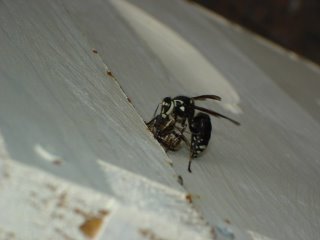
A few minutes after the hornet started eating, the bees noticed. Two bees swooped down and attacked the hornet. They are out of focus (they were really moving fast) but the red arrows on the picture indicate where the bees are.
After several swoop attacks, the hornet flew off, leaving the remains of the bee behind.
I'm concerned about the hornet's continued presence. I watched a video on Youtube about 30 hornets wiping out a beehive in a little over 3 hours. I don't know whether to worry or not.
So far I've seen one dead hornet, killed by the bees and this one being run off by the bees.


Saturday, July 15, 2006
Inspection today

I opened the hives today for the first time in two weeks.
On Bermuda the top three shallow supers are full. I chose with my hives (to cope with the weight of full containers) to put a deep on the bottom and a medium above it. Then I added the supposed honey supers as shallows above that.
The super closest to the two bottom hive bodies has both honey and brood in it in Bermuda. This means that the bees needed that space for growing new bees, so I won't take that super for me.

However
 all three Bermuda supers are full and mostly capped, so I'll need to add another super tomorrow ASAP.
all three Bermuda supers are full and mostly capped, so I'll need to add another super tomorrow ASAP.Destin, which previously had one full super and two empty ones, now has two completely full and capped shallow supers (no brood in these supers). I moved the remaining empty super to the lowest honey super position, directly above the brood boxes. We'll see what happens.
Look at the huge numbers of bees on top of the super! I took this one from the middle and put it on top - wow, what a lot of bees!
Both hives seem to be thriving. I did see a lot of small hive beetles in the inner covers of both hives and smushed as many of them as I could with my hive tool.

Friday, July 14, 2006
A Bee Grade Movie
My son-in-law has put a great movie on his blog for my new grandson. He has a real movie camera. I decided to make a movie of my bees with my digital camera and put it up on this blog, just for fun!
Click on the play arrow to start the very short video.
Click on the play arrow to start the very short video.
Wednesday, July 12, 2006
Death to the Intruder!
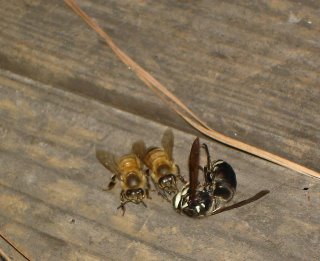
My girls killed a bald-faced hornet who was trying to rob the hive today. This is the second one I've seen that they have killed. The bald-faced hornet is actually a cousin to the yellow-jacket. They live in paper nests that they build out of wood.
Since bald-faced hornets often like to eat live prey, I wonder if the hornet were trying to kill bees rather than steal honey. The bees won, whatever the motive for the visit of the hornet.
It took two mortician bees to try to remove the body. I watched them struggle for at least 10 minutes.
After a while one bee gave up and left the task to her sister. This poor little bee pulled and dragged the bald-faced hornet until she snagged on a crack in the deck between boards.
Finally she abandoned the task when she had dragged the hornet about 4 feet from the hive stand.
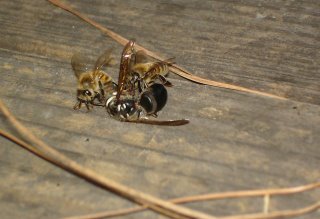
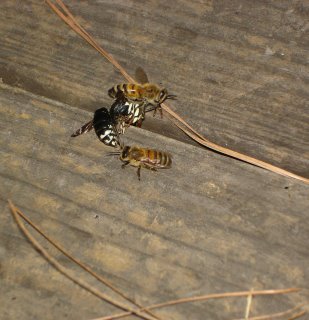
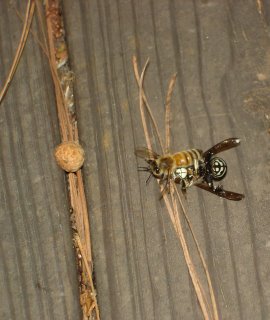

Bees and Queen Anne's Lace
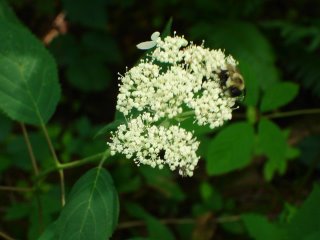
I tried very hard while in the mountains to capture a picture of the many bees I saw on the Queen Anne's Lace blooming in the woods. Every picture was out of focus because the bees absolutely skip across the flower. They are supposed to get nectar from the Queen Anne's Lace but I don't see how they pause long enough to accomplish that.

The fruit of the Solomon's Seal did stand still for my picture as did these two ducks on a log at the lake at Black Rock Mountain.


Saturday, July 08, 2006
I have sourwood trees!

I'm thrilled to find out that I have sourwood trees on my property in the North Georgia mountains. Sourwood is treasured honey for those who know the difference.
Here is a close-up of a sourwood flower. You can see why it is commonly called the lily of the valley tree. In North Georgia the sourwood is peaking right now. The bloom started at the end of June.
I don't have beehives at my mountain house right now because of the bears. There are five bears that live on the mountain - three adults and two cubs. Others who live up here see them regularly.
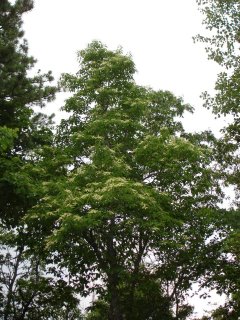
Jamie Ellis, PhD, bee expert from UGA, told me that I would need an electric fence to keep the bears out. He suggested that I set up the fence and drape bacon on the wires. Then when the bears went for the bacon, they would be shocked and learn not to go into the fence to get the hives.
With all of this blooming sourwood (these pictures are all taken on my property), I feel determined to find out how to put hives up here next year. I have the perfect spot for two or three hives with a southern exposure looking down the mountain toward many sourwood trees and with forest behind as well.
I've gotten so accustomed to looking at my hives every day at home - it will be odd to set up hives that I only see every three weeks or so. The problems will certainly be different, more global. I'll probably have to deal with swarms, hungry bees, no close-by water source.....hmmmm......among other problems yet to be discovered.

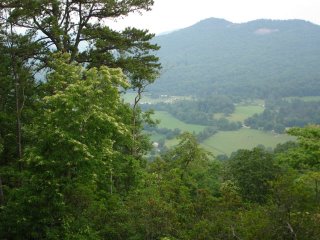

Wednesday, July 05, 2006
Beekeeping in North Carolina
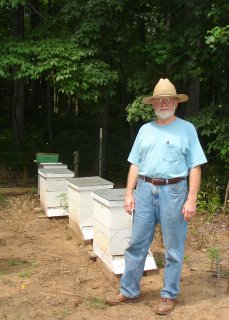
I'm in North Georgia for the July 4th week. While here I went to visit my new friend Ed to see his bees. Ed has four beehives in North Carolina just over the Georgia line. His hives are in a beeyard protected from bears by an electric fence with a solar powered battery. He shares his beeyard with about 30 hives belonging to Bob Binnie, a well-known N Georgia beekeeper from Lakemont, Georgia.
Bob unexpectedly arrived at Ed's house just before I did so I was lucky to get a free lesson about bees from someone who really knows his bees. Bob is one of the speakers at
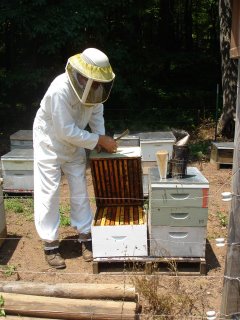 EAS(Eastern Apiculture Society) in Young Harris, Georgia in August this year. His topic is "Breaking in to New Markets." Bob sells his honey all over this area.
EAS(Eastern Apiculture Society) in Young Harris, Georgia in August this year. His topic is "Breaking in to New Markets." Bob sells his honey all over this area.Ed and Bob wait until the sourwood is in bloom to put honey supers on their hives. I wondered why the bees didn't swarm if they had to wait this long before getting space to expand. Bob (in my wonderful private bee lesson) explained that the hives at Ed's place were mostly new splits, started in May, so in fact were just now at production strength.
I have to confess that I have never seen the queen in either of my hives or in any hive. Bob showed me the queen in one of the hives and I was thrilled to see her. He also showed me a queen cell and many examples from Ed's hives of great brood patterns.
I also learned from Bob how he lights his smoker. Everyone seems to have a different trick. Bob's (and as a result Ed does this too) is to use a paper towel. He fills the smoker with thick twine and a paper towel and then lights the towel. Unlike mine, which I can spend a minimum of 15 minutes trying to light, his went up in thick smoke right away. He keeps it running with pellets he gets from Dadant.
So for smokers so far:
--Virginia Webb uses wood chips and puts some in the bottom, lights them and keeps feeding the chips.
--My friend and mentor, Nickie, in Atlanta uses hamster cedar chips and pine needles
--Bob Binnie and Ed use paper towels to start the action and then feed Dadant pellets
--I, who take forever to get mine lit, use dryer lint, cedar chips and anything I can find that will burn......hmmm, I think it will be paper towels for me going forward!

It was certainly a privilege to see Bob in action. I asked him about his hives in the Rabun Gap area where my house is and it happens that he supplies the observation hive bees at Osage produce market where I buy local produce daily when I am up here. His hives line the highway beside Osage as well. After my afternoon at Ed's, I went back to Osage and found the queen in Bob's observation hive there!
When I was a little girl, we had a housekeeper who would also say, "We live and learn and dies and forgets it all." Goodness, I hope I remember all I observed while watching Bob.


Subscribe to:
Posts (Atom)
